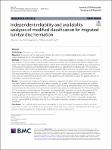Item Infomation
Full metadata record
| DC Field | Value | Language |
|---|---|---|
| dc.contributor.author | Wenshuo, Gao | - |
| dc.contributor.author | Wei, Zhang | - |
| dc.contributor.author | Pan, Hao | - |
| dc.contributor.author | Wang, Dong | - |
| dc.date.accessioned | 2023-03-16T04:17:33Z | - |
| dc.date.available | 2023-03-16T04:17:33Z | - |
| dc.date.issued | 2023 | - |
| dc.identifier.uri | https://link.springer.com/article/10.1186/s13018-023-03688-7 | - |
| dc.identifier.uri | https://dlib.phenikaa-uni.edu.vn/handle/PNK/6903 | - |
| dc.description | CC BY | - |
| dc.description.abstract | In this study, the incidence of migrated lumbar disc herniation was about 10.5%, and most of the patients were male. Patients with higher BMI are more likely to develop this disease. Our study confirmed that the modified classification has moderate to high confidence. During the 2-year follow-up period, 66 patients (62.9%) were treated conservatively, and the patients with conservative treatment were mainly A2 and B2 type (59.1%). Thirty-nine patients (37.1%) underwent surgical treatment. The patients recovered well after operation, and the low back pain and ODI index were significantly improved at 1 year after operation (P < 0.05). We suggest that type A1 and B1 migrated nucleus pulposus can be removed by posterior approach. For type A2, B2, C1, C2, the lateral approach is recommended to remove the nucleus pulposus directly. Logistic regression and ROC analysis showed that disease duration (≥ 1 year) and BMI (≥ 24) maybe were risk factors for surgical treatment of patients with migrated lumbar disc herniation. | vi |
| dc.language.iso | en | vi |
| dc.publisher | Springer | vi |
| dc.subject | migrated lumbar disc herniation | - |
| dc.subject | nucleus pulposus directly | - |
| dc.title | Independent reliability and availability analyses of modified classification for migrated lumbar disc herniation | vi |
| dc.type | Book | vi |
| Appears in Collections | ||
| OER- Y học- Điều dưỡng | ||
Files in This Item:

